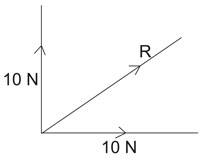|
Question
1.
A block of
mass 2.0 kg resting on a smooth horizontal plane is acted upon simultaneously by
two forces, 10 N due North and 10 N due East. The magnitude of the acceleration
produced by the forces on the block is?
Solution:
Using
the formula for force, F = ma
Given, force
= ?, mass = 2.0 kg, acceleration = ?
First, find
the net force of the two acting on the mass.

Using pythagora's theorem, the resultant force, R is
given as
R2 = 102 + 102
R
= √(102 +
102) = √200 = 14.4 N
Applying
the net force to the force formula,
F = ma
14.14
= 2.0 x a
a =
14.14/2 = 7.07 m/s2
Question
2.
A 0.05kg
bullet travelling at 500 ms-1 horizontally strikes a thick vertical wall. It
stops after penetrating through the wall a horizontal distance of 0.25 m. What
is the magnitude of the average force the wall exerts on the bullet?
Solution:
The force
the wall exerted on the bullet in bringing it to rest or stop equals the force
the bullet was travelling with.
Using the formula for force, F = ma
Given: mass
= 0.05 kg, initial velocity u = 500 ms-1, final velocity v = 0,
distance travelled = 0.25 m, acceleration = ?
To find the
acceleration of the bullet, use the equation of motion,
v2
= u2 + 2as, where v = final velocity, u = initial velocity,
a = acceleration, s = distance moved.
Therefore,
from the equation of motion,
a = (v2
- u2)/2s
substituting
(v2 - u2/2s ) for a in the force equation, we have
F = m
(v2 - u2/2s)
F =
0.05 ((0 - 5002)/2 x 0.25)
=
25 000 N
The force
the wall exerted on the bullet is 25 000 Newtons.
Question
3.
When taking
a penalty kick, a footballer applies a force of 30.0 N for a period of 0.05s. If
the mass of the ball is 0.075 kg, calculate the speed with which the ball moves
off.
Solution:
Using the
formula for force,
F = m (v - u/t)
Given: Force = 30 N, mass = 0.075 kg, initial velocity,
u = 0, final velocity, v = ?, time t = 0.05 s
Therefore, with the above force formula,
30 =
0.075 (v - 0/0.05)
0.075 v = 30 x 0.05
v = 30 x 0.05/0.075
= 20
The speed (or velocity with which
the ball moves off is 20 m/s
Question 4.
A body of mass 2 kg moving vertically upwards has its velocity increased uniformly from 10 ms-1 to 40 ms-1 in
4s. Neglecting air resistance, calculate the upward vertical force acting on the
body, taking acceleration due to gravity as 10 ms-2.
Solution:
Neglecting air resistance, two forces act on the body as it
moves upwards: (1) the upward vertical force, F, and (2) the downward force due to gravity, mg.
The net
force is the difference between the two forces.
i.e.
F - mg = ma
F = ma + mg
F = m (a + g)
Notice that a = Dv/t
= v - u/t
= 40 - 10/ 4
= 30/4 = 7.5 ms-2
Therefore, from
F = m (a + g)
F = 2 (7.5 + 10)
F = 2 x 17.5
F = 35 N
The upward vertical force acting on the body is 35 Newtons
Question 5.
A force on a body causes a change in the momentum of the body
from 12 kgms-1 to 16 kgms-1 in 0.2s. Calculate the
magnitude of the impulse.
Solution:
From Newton's second law of motion
F = (mv - mu)/t
Ft = mv - mu
Ft = Impulse (I)
Therefore, I = mv - mu
Where mv = final momentum, mu = initial momentum.
I
= 16 - 12 = 4 Ns
See more calculations of force based on Newton's second law of motion.
|